The Power of One: One-Employee Establishments in Indiana
When we think about Hoosier employers, we tend to think about the names in the news: Honda, Toyota, GM, Eli Lilly, Alcoa and other firms with a substantial Indiana presence. But when you dig a little deeper into the makeup of Indiana's employers by size, you find that one is the modal (or most commonly-occurring) size among Indiana's establishments. (1) And while these one-employee businesses are by definition tiny, there are lots of them, and they have a role to play in Indiana's economy.
There were 24,932 firms with rounded average employment of one for the third quarter of 2006 and 90,787 establishments with employment between one and nine. (2) The one-to-nine firms comprised 57 percent of all private sector establishments with average employment greater than zero. Wages for this latter group totaled $2.4 billion for 2006:3—8 percent of all wages paid for in-scope employers. For purposes of this study, the scope was refined to include firms with employment equal to one for at least two months of the quarter and third month employment of one or zero; this limitation yielded 22,321 establishments. Wages for these employees amounted to $240 million, or 0.8 percent of all private payrolls for the quarter. The selected firms included 1,659 locations that are sub-units of larger employer accounts (e.g. a manufacturer's wholesale representative or a regional inspector or supervisor) broken out separately based on location or nature of the business.
Steady Growth
A comparative analysis of third quarter files for 1996, 2001 and 2006 reveals a steady growth in the number of firms that fit this category over the past decade. In 1996, there were 19,092 firms meeting the criteria; in 2001, there were 20,496—an increase of 7 percent. That growth accelerated slightly between 2001 and 2006, when the count grew to 22,321 establishments, a 9 percent increase for the five-year period.
Figure 1 shows the change in firm counts between 2001 and 2006 for selected industry sectors with 500 or more one-employee establishments. Since industry codes were not converted to the North American Industrial Classification System (NAICS) until 2001, comparisons to 1996 are impracticable.
Figure 1: Change in One-Employee Establishments by Selected Sectors, 2001-2006
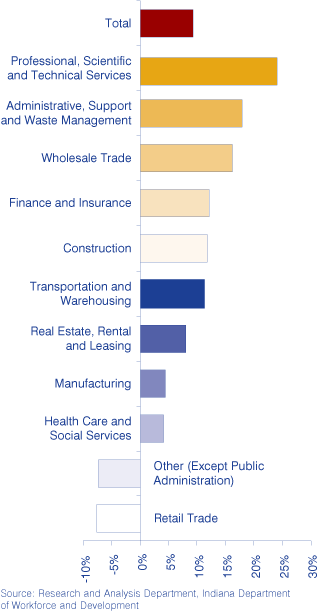
Figure 2, which depicts a detailed industry breakout for the sectors with concentrations of one-employee establishments in the third quarter of 2006, shows few surprises. The firm counts are led by professional, scientific and technical services. This includes lawyers, accountants, architects, and marketing and advertising services, among others.
Figure 2: Distribution of One-Employee Firms by Industry Sector, 2006:3
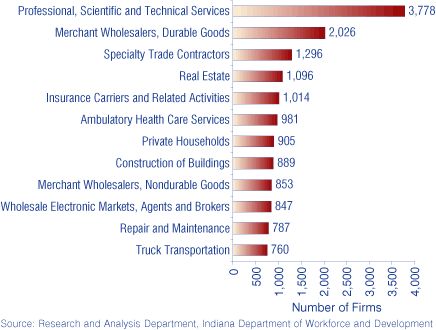
Durable goods wholesalers are followed by specialty trade contractors, real estate services, and insurance and related (which includes insurance agents). Ambulatory health care includes offices of doctors, dentists, chiropractors, etc., while private household employees include cooks, maids, nannies, gardeners and so forth.
Construction of buildings includes general contractors, both residential and commercial. Wholesale electronic markets and agents and brokers includes firms that arrange for the sale of goods owned by others, generally for a fee or on a commission basis, including business-to-business electronic markets using the Internet or other electronic means.
Nondurable goods wholesalers (non-electronic), providers of repair and maintenance services and truck transportation round out the sectors having 500 or more firms at the three-digit NAICS level.
Geographic Distribution
Figure 3 shows the geographic distribution of one-employee firms in the third quarter of 2006, with the firms sprinkled in every county of the state, but concentrated around the Indianapolis hub and other large metropolitan areas.
Figure 3: Geographic Distribution of One-Employee Firms, 2006:3
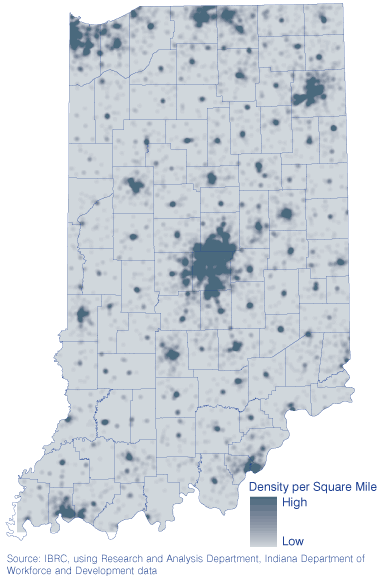
Figure 4 shows the distribution of one-employee firms by economic growth region. Note that some firms cannot be coded for a specific county due to the nature of business or the “territory” for which the employee is responsible; such firms are coded as statewide. There are 3,178 firms that fit this classification, making up 14 percent of the state.
Figure 4: Distribution of One-Employee Firms by EGR, 2006:3
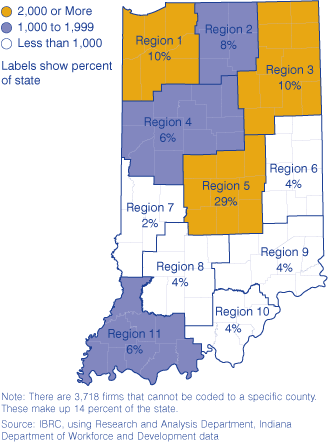
Incorporation
Almost three-quarters (16,357 or 73 percent) of these one-employee firms are incorporated in some fashion (e.g. professional corporations, limited liability corporations, etc.) as indicated by the establishment name, or by identification as a corporation at the time the employer account was established. Average wages for these incorporated firms are over twice those of their unincorporated peers ($12,430 vs. $6,019 for the quarter). Overall, quarterly wages for this employer segment averaged $10,718. Of the unincorporated establishments—which totaled 5,964—1,498 were in repair and maintenance, 875 in professional, scientific and technical services, 703 in construction and 611 in insurance. The remainder were scattered across other industry sectors.
Establishment Age
The oldest active establishment included in this study (based on the date it began paying unemployment taxes) has been in existence since 1936; five others started before 1950 and 55 more before 1960. Eighty-six of the still-active one-employee firms were established between 1960 and 1969. However, the majority of Indiana's one-employee firms are of more recent vintage, with approximately two-thirds (14,032) arriving on the scene since January 2000, including 2,779 in 2006 (see Figure 5).
Figure 5: One-Employee Firms by Year Established, 2006:3
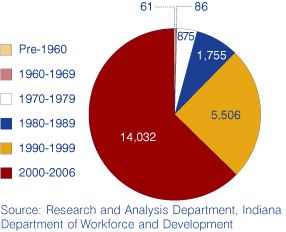
Closing Thoughts
One-employee firms are a vital part of Indiana's economy, providing employment for nearly 25,000 Hoosiers. These businesses span the spectrum of industries from construction or repair services to health care and legal services. In many cases, these are employees of the businesses who prepare our taxes, answer our legal questions, supply various office or home services or serve as health care providers.
One-employee firms do not necessarily remain that way, and many firms that start with one employee outgrow the category. Many business start-ups fall into this category, making it a closely watched segment of the economy for analysts concerned with business births.
In a future analysis, we will examine the experience of one-employee firms over time to explore the incidence of business births and deaths (using the Bureau of Labor Statistics' Business Employment Dynamics series and other sources) and what proportion of the one-employee firms do indeed expand over time.
Notes
- An establishment (also referred to as a firm) may be a sub-unit of a larger employer account that is reported separately based on location or nature of business.
- Third quarter employer data from 2006 were used for this research and include all employers covered under Indiana's unemployment insurance law. Government establishments and those with average employment less than one were not included in this research.
Vicki Seegert, Manager
Research and Analysis,
Advanced Economic and Market Analysis, Indiana Department of Workforce Development
